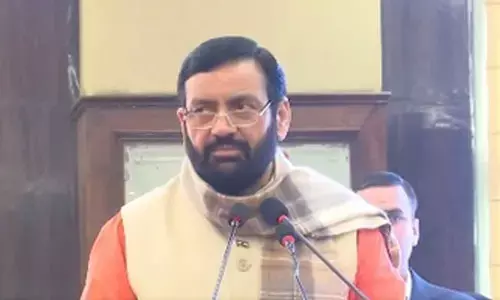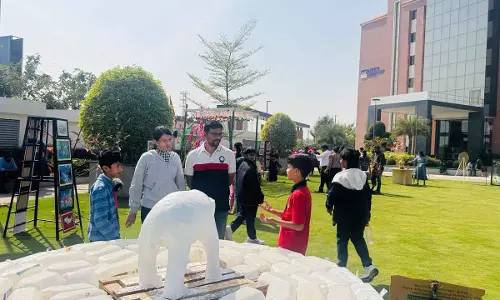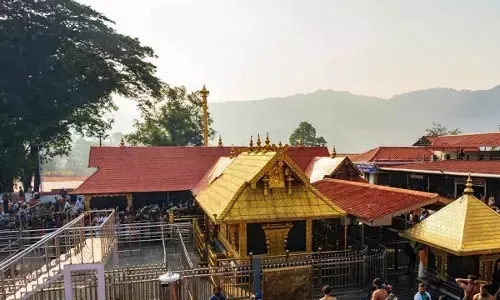No knowledge beyond Astagiri

The West Side of ‘Ancient Indian Geography’ as depicted by Valmiki Ramayana
The impeccable knowledge exhibited by Maharshi Valmiki in his Sanskrit Ramayana and equally similar to that by Vasudasa Swamy in his unmatchable and first and, perhaps, last of its kind translation into Telugu titled ‘Andhra Valmiki Ramayana,’ about the geographical details of the Ancient Universe, many of which may now be found in Google Maps, is simply astounding. The context is in the ‘Kishkindha Kanda.’ After Sri Rama befriended Monkey King Sugreeva and fulfilled his desire to kill Vali, it was the turn of Sugreeva to fulfill his promise made to Sri Rama to find the whereabouts of Sita abducted by Ravana.
As part of this, and after sending monkey chiefs to East and South, Sugreeva directed another monkey chief Sushena, father of Lady Tara, to search for Sita in the Western direction. In the process, Sugreeva described the west side topography comprising magnificent mountains in northwest of India, the ocean (present Arabian Sea) down south to it, and Persian (Iran is divided into 31 provinces known as Persian Provinces) provinces. Then sequentially the Saurashtra (Now Surat and could also be Kathiawar, a peninsular region of Gujarat, located on the Arabian Sea coast), Bahlika (located on the southern side of Kashmir),Candracitra (present-day Mathura or Shuura Desha) provinces.
In the Western Quarter, encircled with enmeshed mountains, Blest or Holy or Sacred Rivers, whose cool water flows westward, forests of sages, mountains in forestsand lands, including highly towering mountains that are chilly, are seen. From there moving towards the Western Ocean, one can see seawater ruffled by sharks and crocodiles. Later, there can be seen bushes of Ketaka (A tortuous evergreen tree or shrub with conspicuous leg roots and prickly stems), Tamala (an evergreen tree the leaf of which is known as Tejpatta or Tamalpatra or Tejpat or Malabar leaf), and a thick patch of shrubbery with coconut trees. Moving further, the delightful cities along shore, Muraci (Murachipattana), Jatipura, Avantee and Angalopa and forest of Alakshita are seen. Then at the junction of River Sindhu with the ocean, Mouth of Indus, there was the huge Golden Mountain Hemagiri (Could be the same as Hala Range adjacent to Southern Valleys alongside River Sindhu), scattered with abundant gigantic trees. Flying Lions or the winged lions denoting Saint Mark, power and courage, inhibit the attractive edges of that mountain, hauling sharks, fish, and elephant seals to their dens. Elephants inhibiting on top of the mountain are contended, conceited, and trumpeting like thunderous clouds, will be moving everywhere adjoining the mountain abutted by water and nearbyretreats of Flying Lions.
On seagoing or travelling in the ocean, measuring hundred Yojanas of height peak, Mount Pariyatra, a range of mountains in the Central Indiaor could be of Suleiman Range, now in Pakistan, will appear. However, it is highly difficult to see it, since it will be amazingly dazzling. The Mountain is the abode of 24 crores of huge and terrible (human) Gandharvas whose radiance looks like fire and who can change their appearance as they wish. This area could even be Sulaiman Range, in and around present-day Afghanistan and may not be the one in Vindhya Range. Hence, the place could be what is now known as ‘Candahar’ or Afghanistan or the ancient ‘Gandhara Dsha.’
Proceeding further in that sea past Mount Pariyatra, another great Mountain, Vajra Dhara, standing like diamond shaped and shining like Jewel Lapis (deepblue metamorphic rock) will appear. This Mountain too will be spiraling tall of Hundred Yojanas, where assorted trees and mountaineers will be spreading over it .In the fourth quarter of that ocean from land, Mountain Chakra Vantha is there. Vishvakarma, the Divine Architect, constructed a Thousand Spokes wheel (Sahasrara Chakra) on it. This wheel is said to be a machine of weaponry or sub-weapons, and such spectacular facilities are provided by Vishvakarmanot only for Gods, but also to Demons, when they were threatened by enemies. The legend was that Vishnu in the form of Purushottama snatched this wheel weapon from the custody of Hayagriva Demon and also Backbone of another Demon Pancajana, residing there. This Backbone, a conch-shell is known as 'Panchajanya Conch’ handled by Vishnu.
In the sequence, after Sixty Yojanas, Mountain Varaha with Silver Peaks, delightful cliffs and spacious caves will be there, in voidof Rain God’s abode, the ocean. The City of Naraka (Not the one killed by Lord Srikrishna), Pragjyotisha is there, which is completely golden. Said to be the first kingdom of Assam, this mythological area covered parts of modern-day Assam, Bihar, West Bengal, Bhutan, and Bangladesh. In the extension of Mount Varaha, there is seen Mount Meghavanta (Sarva Souvarna), the entirely Golden Mountain containing waterfalls. There, facing waterfalls of the Mountain, the roaring of elephants, wild boars, lions, and tigers will be heard. Group of Gods coronated Lord Indra on this Mountain and hence it was known as Meghavanta.
On proceeding further, there will appear the exuberant Range of Sixty Thousand Golden Mountains, sunny all around with the touch of young Sun. In the midst of that range, there is the unique and kingly Mountain, the Mount Meru (Meru Parvata or Uttara Meru Savarni). This is also known as Sumeru, Sineru, or Maha Meru and considered to be the center of all Physical, Metaphysical, and Spiritual Universes as well as part of the Cosmic Ocean. Varaha, Meghavanta and finally Meru, in sequence could also be mountain peaks of the Zagros range, located across the Arabian Sea in Iran, extending to Iraq.
Vishv Devas, Vasavas, Adityas, Maruts, and other celestials coming for morning prayers to Meru will bide their time for the dusking Sun, and when they conclude worshipping him, the Sun goes to Mount Astagiri, the Setting or Western Mountain 'Sunset' where he vanishes for all beings for that day. The sun travels to reach the western mountain at a speed of 10,000 Amadas (Amada equals to either 8 or 10 miles) per one Ghadiya (Hindu unit of time equal to 24 minutes). It is roughly calculated that the total time taken for the sun to pass from Meru to Astagiri is said to be one and a half hours. There exists a supreme and heavenly castle of Varuna with a Great Hall that shines like Sun and raised by the Divine Architect Vishvakarma. In between Meru and Astagiri, a Gigantic Date Palm Tree (Taala Vruksha) is seen. This evidences that this area could be present-day Arabian and ancient Persian province.
This is where Sage Meru Saavarni, an enlightened Manu and an identical and equivalent character to Brahma, resides. On obliterating the utter darkness of the earthly world up to here, the Sun will go to the Mount Astagiri and from there, no knowledge of those dark and infinite places.
Vasudasa Swamy quoting Ancient Geography commented here that Valmiki makes a mention of a few places only, most of which are mountains in the west, and ends with land of the setting Sun. Obviously, the so-called famed nations of the west, belonging to Egypt, Assyria, and Greece, despite their tall claims, had not risen to power during the time of Valmiki. Even if they were in existence at all, proper communication was not at all established between them and the Indian Aryans.
(Courtesy: Vasudasa Swamy ‘Andhra Valmiki Ramayana’ and Sri Desiraju Hanumanta Rao’s English version of Valmiki Ramayana)
















